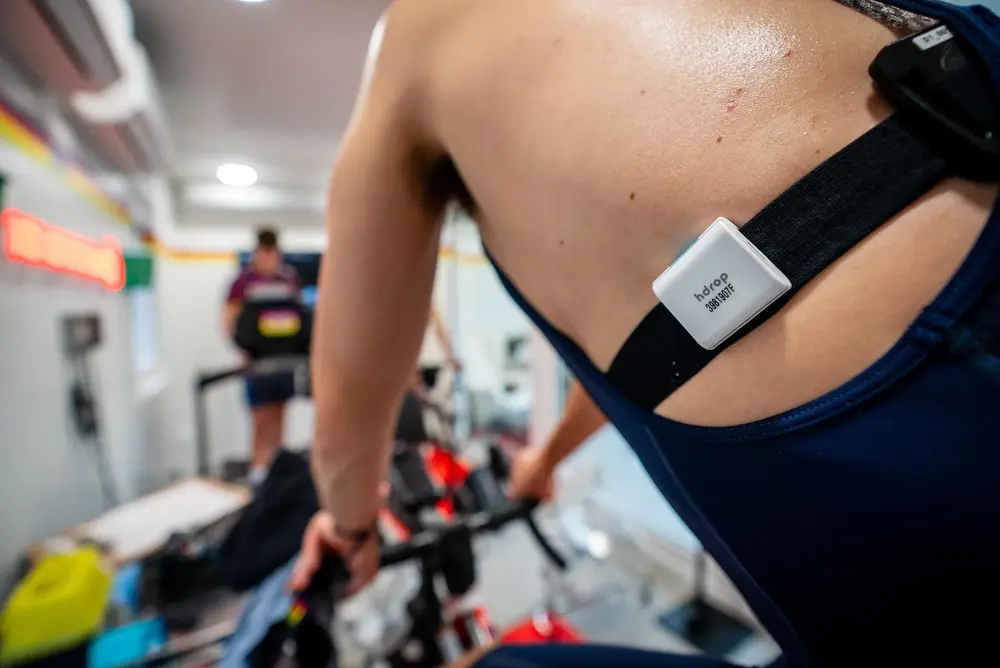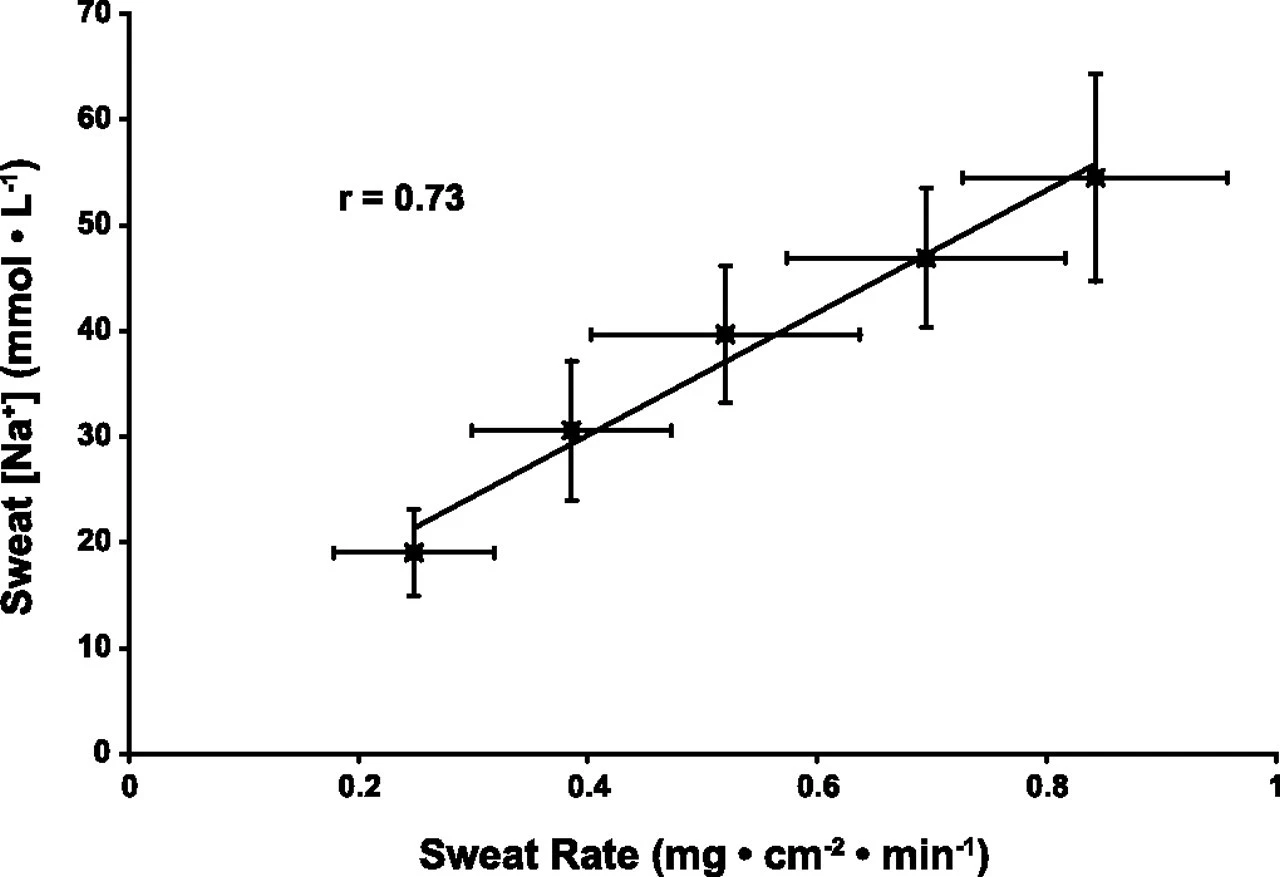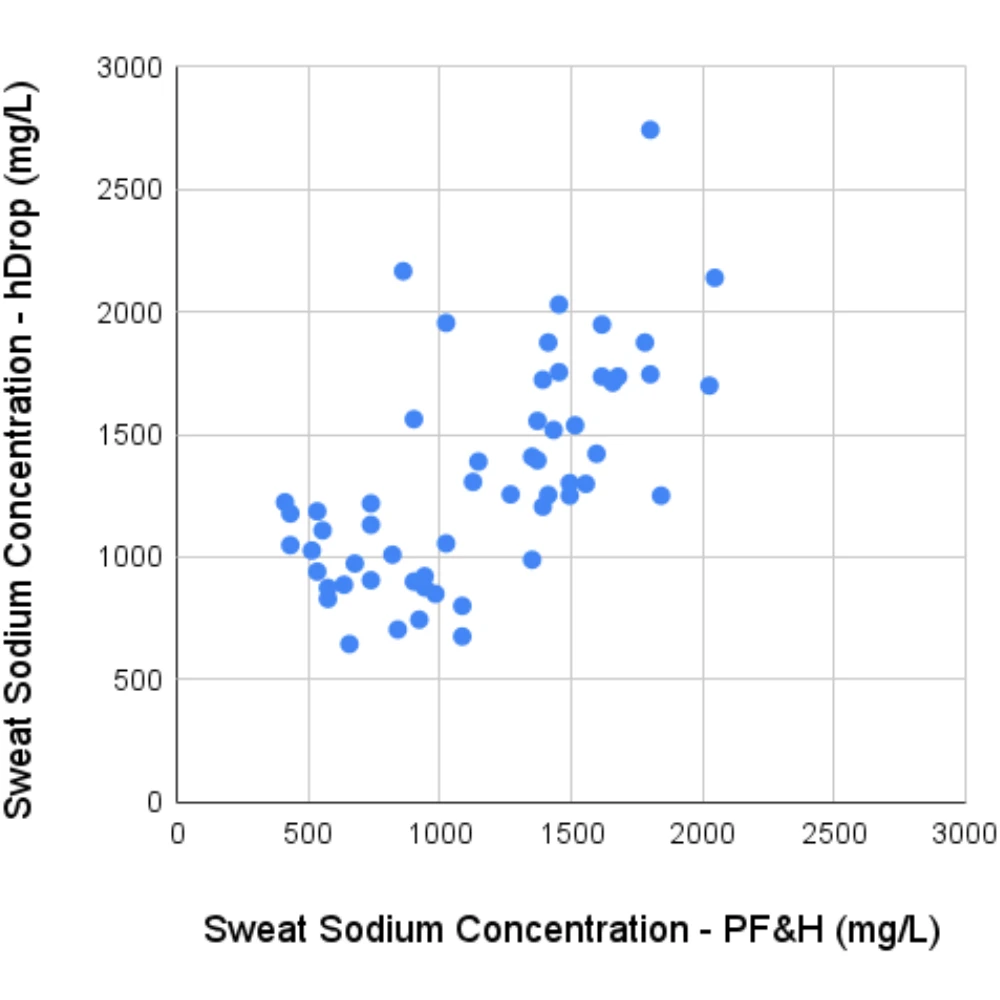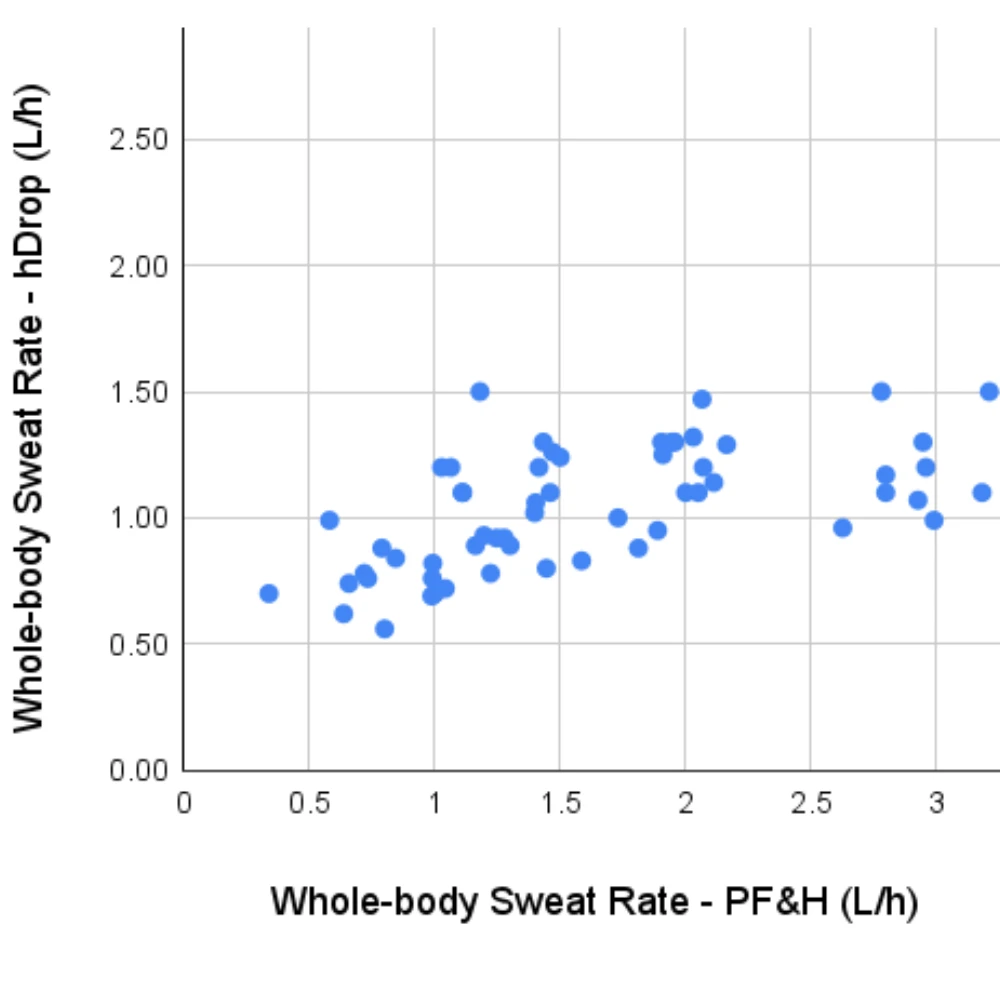At the Precision Performance Lab in Christchurch, Dorset, we’ve been rigorously testing the hDrop hydration sensor to evaluate how well it tracks sweat and electrolyte losses in both real-world and laboratory conditions.
This blog shares our first-hand experience with the hDrop, detailing what it is, how it works, and the insights we’ve gained from our testing. Whether you have questions, need help interpreting results, or want to share your own experiences with the device, we’d love to hear from you! Get in touch at hello@pfandh.com or book a free 20-minute video consultation with one of our team.
The Key Takeaways
The hDrop Sweat Sensor is a wearable device designed to estimate your total sweat and electrolyte losses in real time.
- The sensor attempts to help athletes optimise performance and recovery by tracking sweat rate and electrolyte losses
- We tested the hDrop sensor thoroughly in exercise setting. And we found that the device underestimated sweat rate by 0.58 litres per hour (L/h) compared to pre- and post-exercise changes in nude body mass (-36%)
- It slightly overestimated sweat sodium concentration by 177 milligrams per litre (mg/L) relative to the PF&H Sweat Analyzer (+15%)
- The sensor could be helpful in providing estimations when traditional lab-based testing isn’t accessible, providing valuable insights into hydration needs
- The device syncs with your phone to offer real-time hydration advice and post-session summaries for personalised fluid and electrolyte strategies
Last updated: August 2025

The hDrop Essentials
The hDrop Sweat Sensor is designed to analyse sweat and provide real-time hydration guidance.
What does it do?
The device has three key options for estimating hydration status or starting an activity:
1. A “Thumb Test” - a simple touch-based test that assesses hydration levels by measuring sweat gland activity in the palms and fingers, providing a score out of 100
2. Light activity - suitable for low-intensity movement, such as desk work or gentle walk
3. Intense exercise - designed for athletes, providing real-time hydration insights during training and racing
The hDrop sensor estimates:
- Whole-Body Sweat Loss - tracks the total volume of sweat lost during activity
- Whole-Body Sweat Rate - monitors how much you sweat per hour
- Electrolyte Loss (net/total loss and rate) - estimates key electrolyte losses, specifically reporting sodium and potassium levels during exercise
- Temperature - measures “near skin- temperature to improve sweat rate predictions
The hDrop app presents this data clearly, offering a personalised hydration plan tailored to your sweat composition, workout intensity, and physiology. To help you better understand your hydration status and fine-tune your fluid and electrolyte intake accordingly, the app features three ‘Sweat Zones’:
- Concentrated
- Target
- Diluted
As sweat sodium concentration varies significantly between individuals, primarily due to genetic factors, your Target Zone in the hDrop app is customised based on your average sweat sodium concentration over multiple sessions. While this approach has not yet been validated in research, it’s a unique offering in the market and provides a novel way to present the data to users.
What does it cost?
As of August 2025, the hDrop Gen 2 device is available for £199 (USD $249.99).
This includes:
- 1 x hDrop sensor
- 1 x charging cable
- 1 x travel case
- 2 x upper arm straps (different sizes)
Unlike some hydration monitors that rely on single-use patches, hDrop is fully reusable, making it a more cost-effective and sustainable solution for continuous hydration tracking compared to some of its rivals.
How to use the hDrop sensor?
Wearing the Sensor:
The hDrop sensor can be worn on the upper arm or chest (ensure to select the right location within the app, as this may affect readings), secured with a strap, where it continuously measures sweat composition.
Set-up Steps:
- Secure the sensor - Strap it to your upper arm using the included band or a heart rate chest strap, ensuring good skin contact
- Pair with the app - Connect to the hDrop app before starting your session
- Start sweating - The sensor activates as sweat reaches its detection points
- Log your session - End the session in the app to save your data
How does the hDrop work?
The hDrop sweat sensor is durable and designed for athletes to optimise hydration and performance through real-time sweat analysis. Unlike single-use biosensors, it employs electrochemical and temperature sensors to continuously measure sodium and potassium ion concentrations directly from the skin.
While it doesn’t measure sweat rate directly, it provides estimates based on real-time sweat composition and environmental conditions. If the device were to integrate further with activity tracking apps like Garmin or Wahoo, sweat rate estimates could be significantly improved. Currently, it’s limited by the data the device has access to.
The sensor takes measurements every second, transmitting data to the hDrop app, where users can track electrolyte losses, estimate sweat rate, and refine hydration strategies dynamically.
Hardware and Software Nitty-Gritty:
The hDrop Hydration Sensor connects via Bluetooth to the hDrop mobile app (available on iOS & Android). Athletes can track sweat composition, electrolyte losses, and hydration needs while manually logging fluid intake to refine hydration strategies.
The app continuously reports sweat rate along with sodium and potassium losses and offers post-workout insights, including session sweat loss and rate, sodium concentration, electrolyte trends, and ambient temperature changes.
hDrop integrates with Garmin and Hammerhead devices, and the company reports that future support for Strava, Zwift, and Wahoo is planned.
The sensor has a 120-hour battery life, charges via USB-C, and stores workout data without having to be connected constantly with your phone during an activity.
What are the unique aspects of this device?
The hDrop Hydration Sensor stands out as a reusable, USB-C rechargeable device that provides real-time sweat composition data.
Key Differentiators:
- No single-use patches – Unlike some other hydration sensors, hDrop’s electrochemical sensors continuously monitor sweat directly on the skin without requiring disposable components, whilst offering real-time feedback and hydration guidance
- Offline data storage –The hDrop can continue to log data while away from your device, but an activity must be started and finished while in Bluetooth range
- Cost-effective and sustainable – the design eliminates the waste and recurring costs associated with other disposable sweat sensors
hDrop Customer support:
hDrop offers customer support via email and provides a comprehensive FAQ section on their website, covering device setup, troubleshooting, and app functionality. Throughout testing, the hDrop team was highly responsive, offering clear communication and helpful assistance when needed.
How accurate is the hDrop?
To assess its accuracy, 10 members of the PF&H team tested the hDrop sensor over six months, using it across 57 different cycling and running sessions.
To compare to the PF&H Sweat Analyzer, sweat was also collected from the inside of the upper forearm using a macroduct collection device during exercise. The skin was prepared and cleaned using gauze and deionised water before sampling sweat for sodium concentration analysis. To ensure accuracy, the macroduct was removed before overflowing during collection.
Testing Breakdown:
- 6 running sessions (~62 minutes each) at low to moderate intensity
- 51 cycling sessions, mostly at low to moderate intensity, with some interval efforts
- Session durations ranged from 53 minutes to 2 hours
Environmental Conditions:
- Average ambient/air temperature: 29ºC (84ºF) with 59% relative humidity.
- Temperature range: Low: 15ºC (59ºF) with 81% relative humidity, up to a High: 42ºC (108ºF) with 35% relative humidity
- 31 tests were conducted in temperatures above 30ºC (86ºF)
Key Findings:
Sweat Sodium Concentration:
hDrop overestimated sweat sodium concentration (i.e. how much sodium is lost in sweat) by an average of 177 mg/L compared to sweat collected with a macroduct during exercise and analyzed using the PF&H Sweat Analyzer

The rate of sodium lost through sweating is largely genetically determined but also related to sweat rate. However, small fluctuations in sweat sodium concentration during and between exercise sessions are normal. These variations are likely due to changes in whole-body sweat rate, either through transient shifts in sweat rate within a session or differences between sessions, making direct comparisons challenging.
Our testing suggests hDrop slightly over-reports sweat sodium concentration. While it indicates a higher sodium loss per litre of sweat compared to our data, it’s not wildly off the mark.
Our convenient, at-rest, pilocarpine-based Sweat Test maximally stimulates sweating to determine your sweat sodium concentration. Sweat sodium concentration increases as sweat glands reclaim fewer electrolytes at higher sweat rates. As a result, test results can be higher than what you’d see at lower sweat rates, such as during rest. This makes it a useful predictor of sodium losses during intense exercise.
If you don’t have access to a reference sweat sodium test - such as a PF&H Sweat Test Center - or if you’re looking to track your sodium losses during exercise over time, the hDrop provides valuable insights to help refine your sodium replacement strategy.

If you notice a significant change in your reported sweat sodium concentration between sessions with the hDrop, we recommend collecting more data to verify the new result before making major adjustments to your hydration strategy. This is due to the inherent variability in wearable devices. Sweat sodium levels typically remain stable, unless there’s a major shift in whole-body sweat rate between sessions (such as comparing very low vs. very high sweat rates).
The hDrop provides reasonably accurate sweat sodium concentration estimates, making it a useful tool for refining electrolyte strategies. While it’s not a replacement for lab testing, the hDrop team is actively working to improve its accuracy. For better insights, testing across multiple sessions helps establish a personalised sweat sodium profile.
Sweat Rate Estimation
hDrop underestimated sweat rate (i.e. fluid loss per hour) by an average of 0.58 L/h compared to measurements based on pre- and post-exercise body mass changes.
In extreme cases, sweat rate was underestimated by as much as 1.76 L/h.
| Results | Reference PF&H Sweat Analyzer | hDrop | Mean difference |
|---|---|---|---|
| Sweat sodium concentration (mg/L) | 1149 ± 451 | 1326 ± 440 | 177 |
| Sweat rate (L/h) | 1.62 ± 0.75 | 1.04 ± 0.24 | -0.58 |
Table 1. Data above reported as the average ± standard deviation.
Sweat rate varies significantly within and between individuals. Research shows that factors such as metabolic rate, exercise type (e.g. cycling vs. running), environmental conditions, clothing, body composition, and level of heat adaptation (heat acclimation/acclimatisation status), all influence sweat rate.
To evaluate hDrop’s sweat rate accuracy, we compared it to nude body mass changes pre- and post-exercise, adjusting for fluid and fuel intake following our How to Measure Your Sweat Rate protocol, which provided a benchmark for understanding how hDrop estimates fluid losses in real-world conditions.

Our data showed that hDrop underestimated sweat rate by an average of 0.58L/h, with larger discrepancies at higher sweat rates. While it performed better for athletes with lower sweat rates, it struggled for those sweating out more than 1L/h, where more accurate tracking is most crucial.
While the hDrop generally underestimated sweat sodium concentration and sweat rate, it can still be a useful tool for estimating fluid loss to some degree. But, body mass measurements - pre- and post-exercise - remain the most accurate method. We recommend cross-referencing hDrop sweat rate data with body mass changes and repeating sessions under similar conditions to establish a more reliable personal hydration profile.
The hDrop's underestimation can be problematic as it may lead to significant under-rehydration, increasing the risk of insufficient fluid replacement, higher levels of dehydration, fatigue, and performance decline in endurance events.
It’s worth noting that one individual completed 22% of the total trials, 12 out of 57, and this individual saw high sweat rates, which were not surprising and are consistent with his high fitness levels. During their trials, the hDrop reported a sweat rate of 1.2L/h compared to the measured data of 2.75L/h. The majority of these sessions (10) were completed as heat training sessions in our Performance Lab at ~39ºC with 40% relative humidity.
If we are to remove this individual's data, the resulting differences are reduced:
- The average measured sweat rate is 1.35L/h, and the average hDrop sweat rate is 1.02L/h
- This individual increased the average error between the measured and estimated sweat rate from the hDrop
- We’ve highlighted this to help you make your own decisions around the device's usefulness for you
- If you're sure you don’t sweat high amounts very frequently (>1.0L/h), the hDrop’s performance for estimating your sweat rate may be acceptable
- If you're an individual who is a certified 'sweat machine' (i.e. you have a high sweat rate!), then, for now at least, you’ll likely be better off sticking with the tried and tested method of pre-post body mass measures
| Participant | Measured Sweat Rate (L/h) | hDrop Sweat Rate (L/h) | Number of trials (n) |
|---|---|---|---|
| P1 | 2.75 | 1.16 | 12 |
| P2 | 1.48 | 1.06 | 18 |
| P3 | 1.42 | 0.80 | 3 |
| P4 | 1.39 | 1.21 | 6 |
| P5 | 1.11 | 1.10 | 1 |
| P6 | 1.25 | 0.92 | 1 |
| P7 | 1.95 | 1.23 | 5 |
| P8 | 0.82 | 0.80 | 10 |
| P9 | 0.99 | 0.76 | 1 |
| Total | 1.62 | 1.04 | 57 |
Table 2. Individual test data for Sweat Rate estimated by the hDrop and measured by nude body mass change (L/h)
Best Practices for High-Sweaters (>1.0L/h)
If you train or race in hot and humid conditions, where sweat rates exceed 1.0L/h and dehydration risk increases, tracking sodium concentration trends with hDrop can help fine-tune your hydration plan. But, we recommend using body mass-based sweat rate measurements to validate hDrop’s accuracy for your individual fluid needs, given the lack of agreement between hDrop’s sweat loss estimates and gold standard sweat rate data from pre- and post-body mass measures.
Recommended Guidelines for Using hDrop
- Complete at least 10 tests across different conditions
- Vary intensity, duration, and type of sessions (indoor vs. outdoor, cycling vs. running, etc.)
- Record your own sweat rate separately via body weight changes
- Use the hDrop app’s Sweat Zones and compare trends across sessions to refine your electrolyte replacement strategy
What’s Next?
We plan to continue testing hDrop in hot and humid conditions and will update our insights as more data becomes available. Additionally, we’ll also be monitoring hDrop’s software and hardware updates, providing ongoing feedback as the device evolves.
